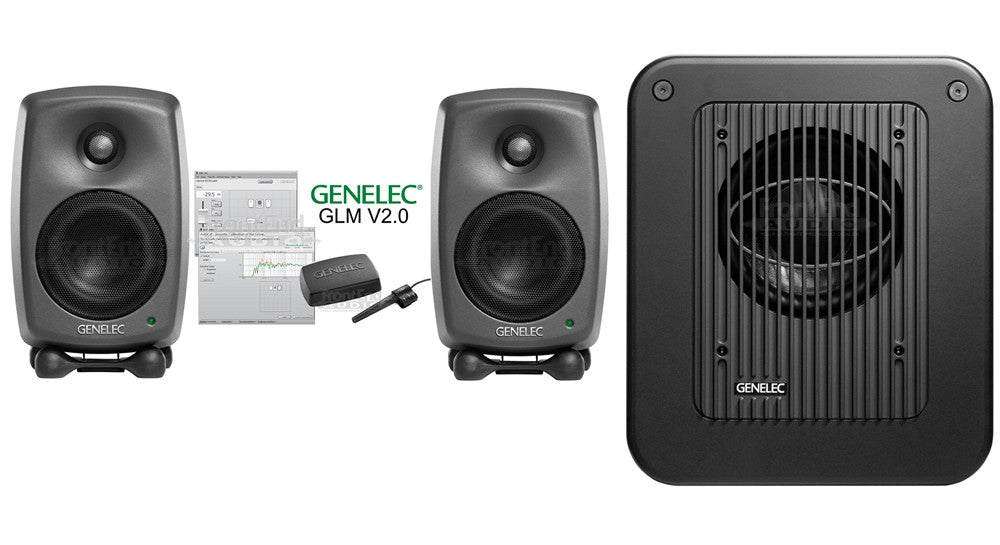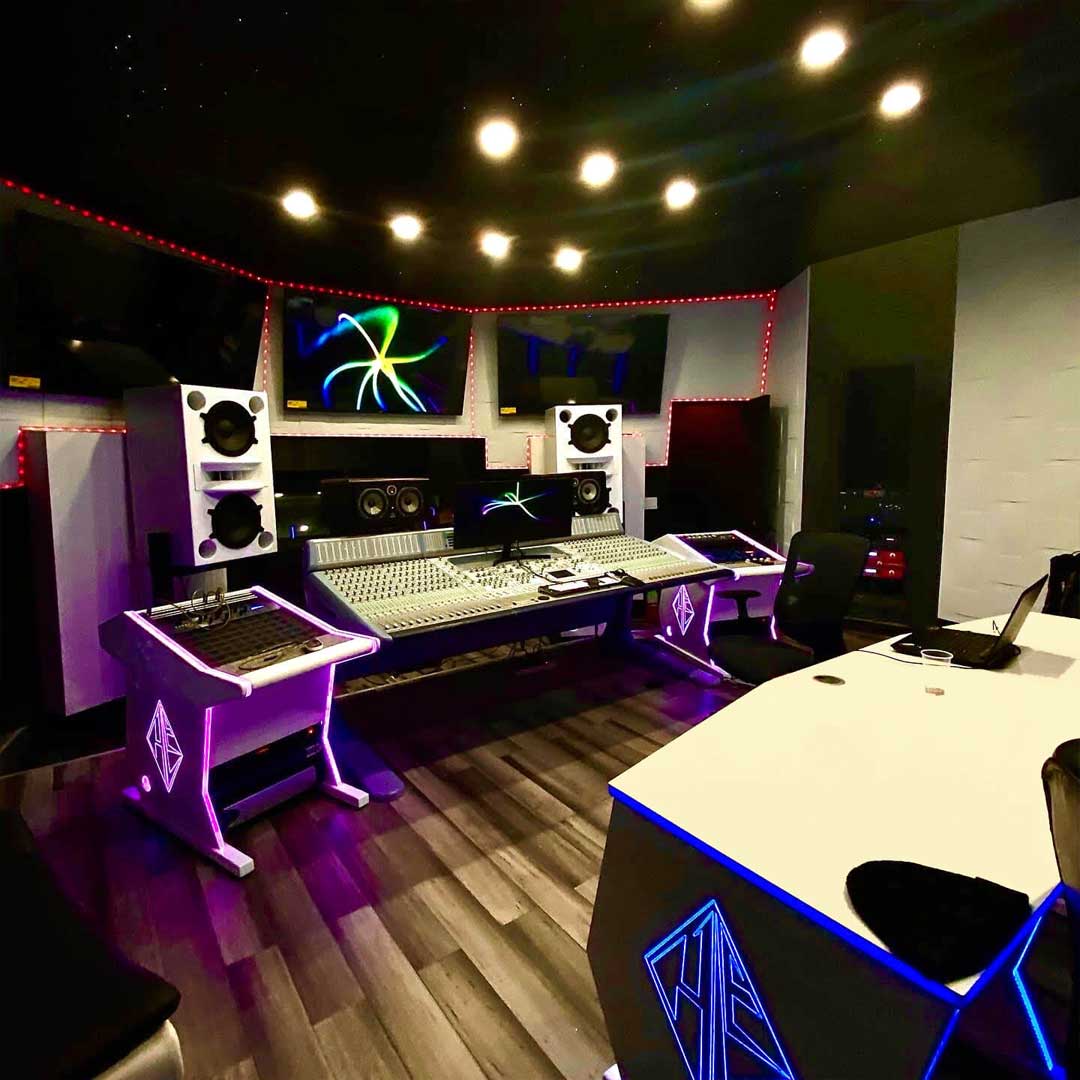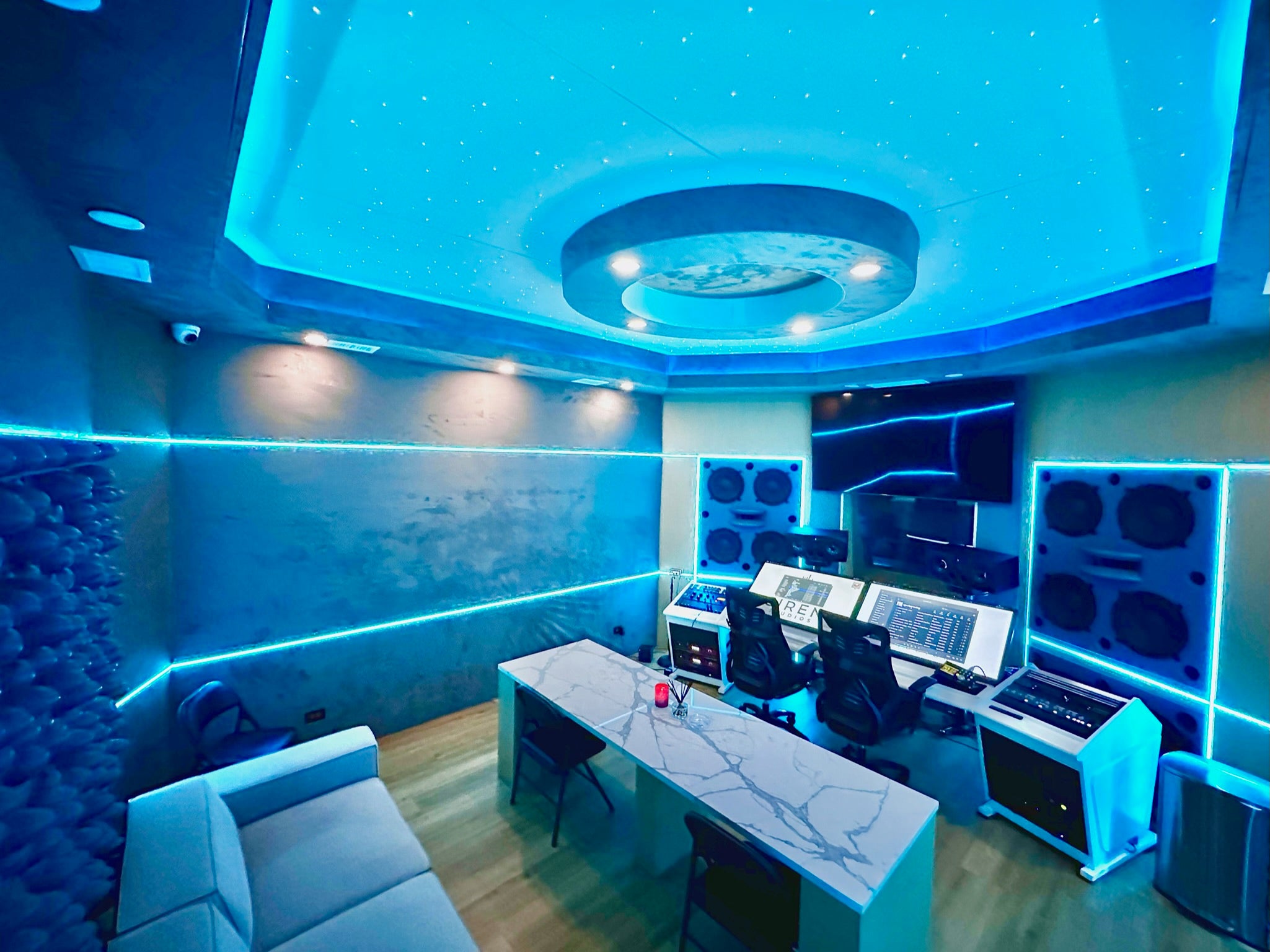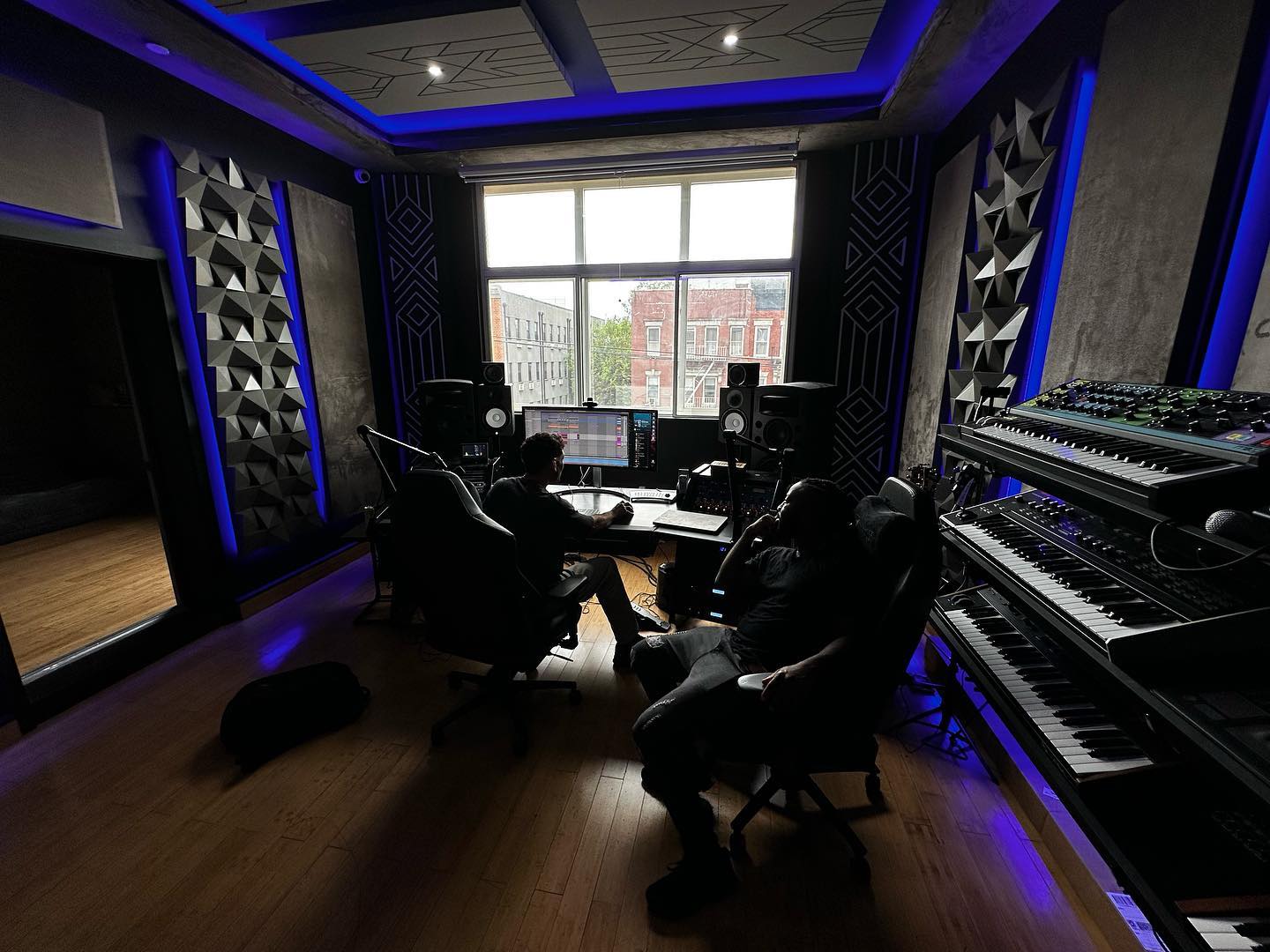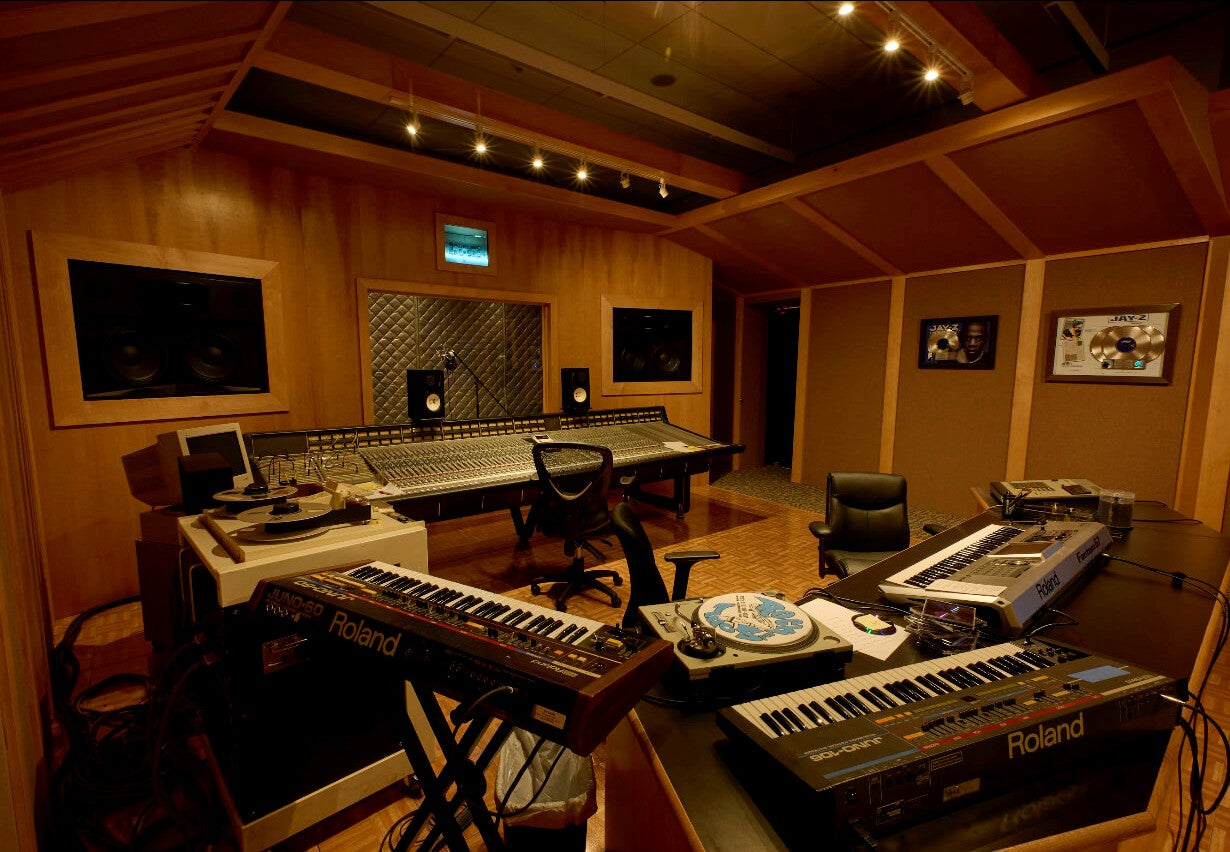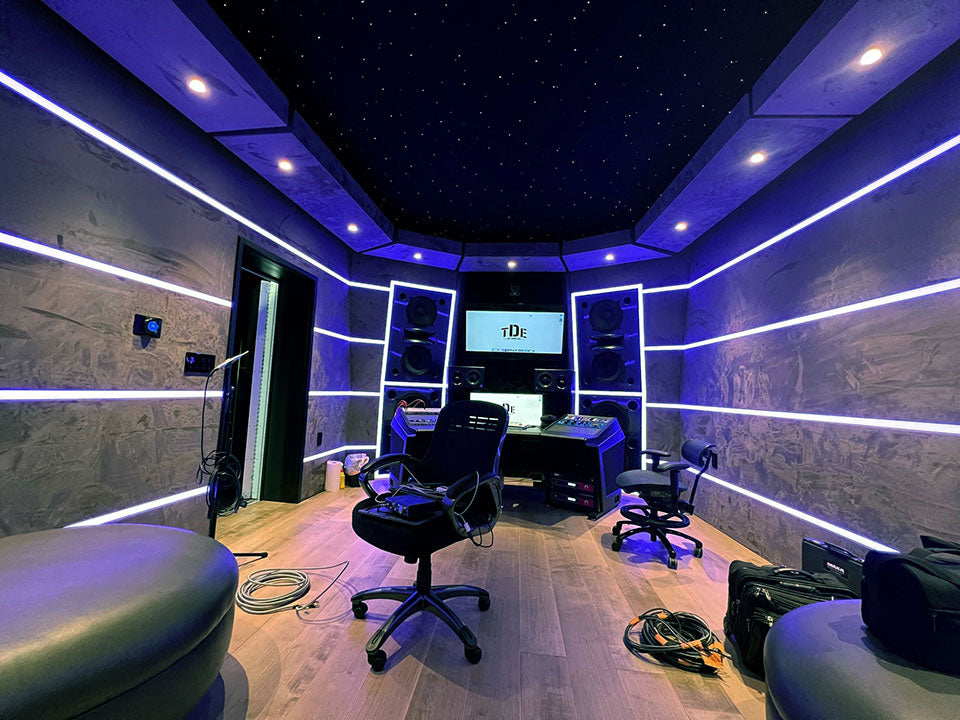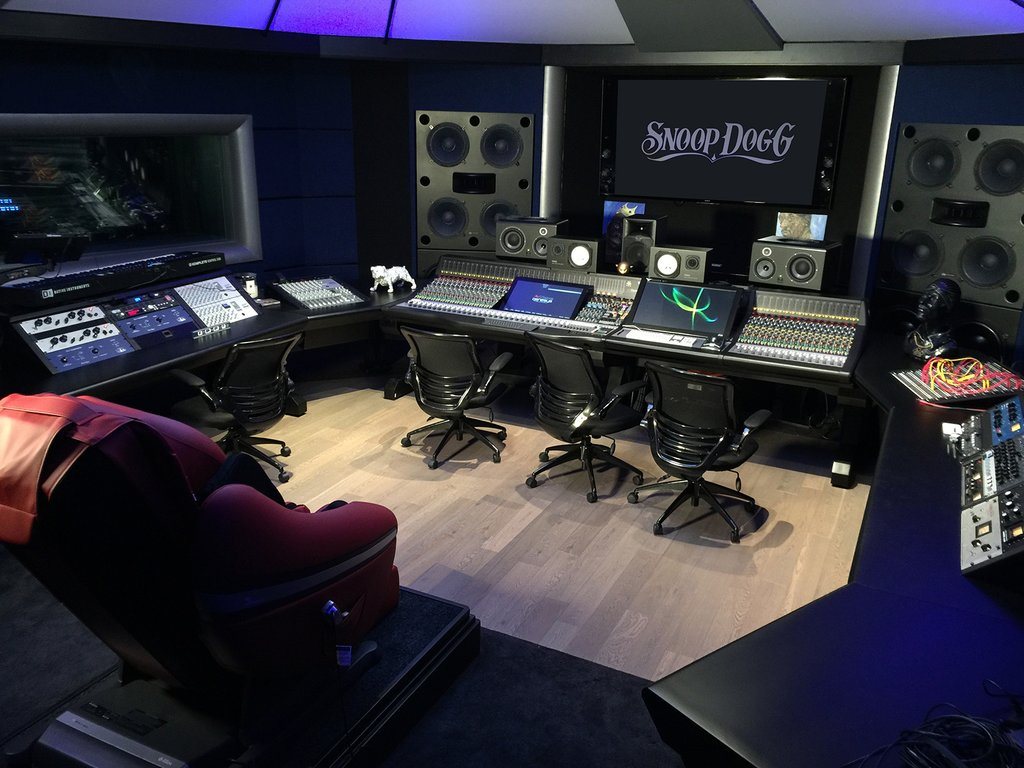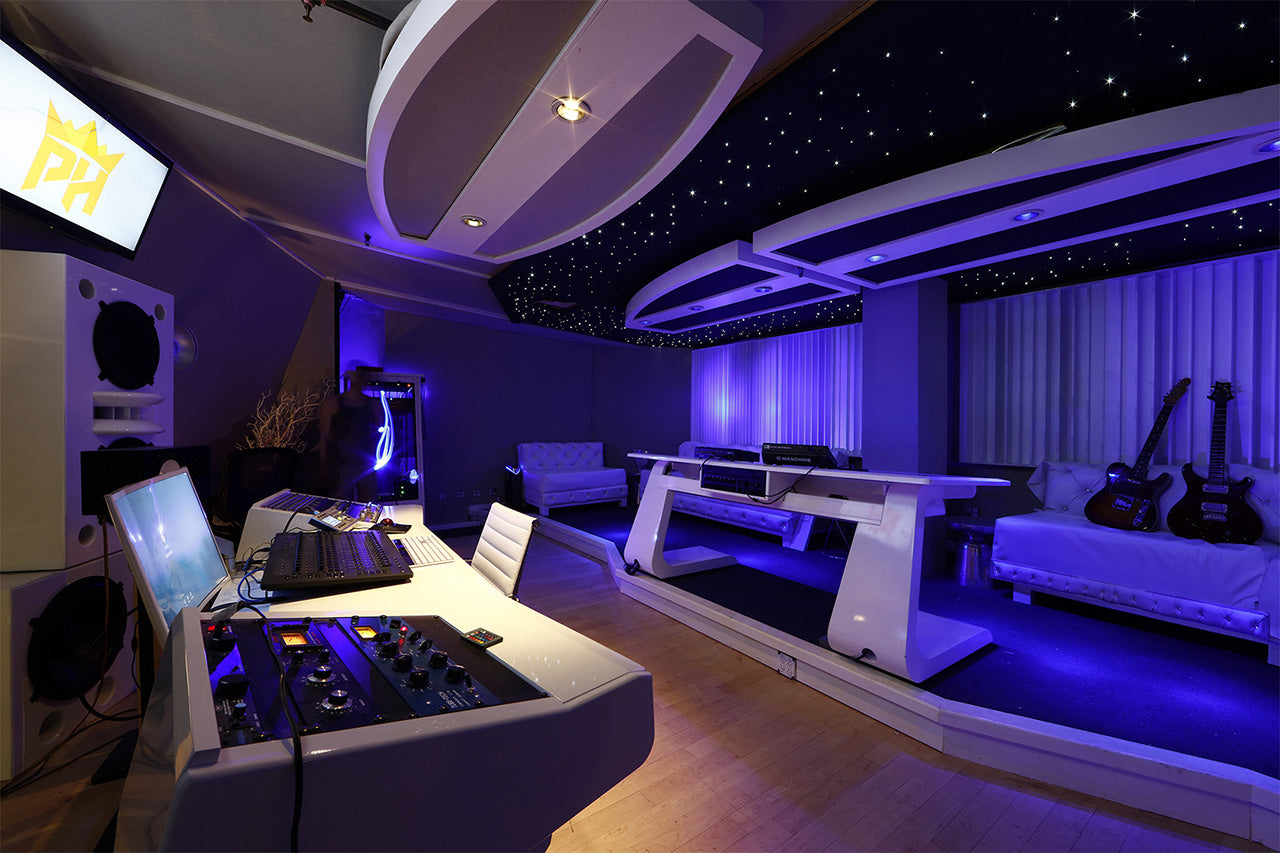The Genelec 8320.LSE Triple SAM Kit comprises two 8320A 4" bi-amped 100W (50W LF/50W HF) studio monitors with the 150W 7350A smart subwoofer and GLM 2 loudspeaker management kit, software, and wired volume control.
If you don't want to discover how your current pair of small desktop monitors have been clouding your judgment by providing alternative frequency facts, then don't invest in a Genelec 8320.LSE Triple SAM Kit. On the other hand, if you want to throw open the curtains that have been shrouding your mix in virtual darkness, then an 8320.LSE Tri SAM 2.1 system will show you what you've been missing. While the 8320A has remarkable bass output for its size, small desktop monitors do have their limitations when it comes to low frequencies, which in the case of the 8320A bottoms out at 55Hz - not bad for a 4" woofer, but Genelec feels you can do better with the addition of the 7350A LSE subwoofer. The 7350A not only fits into small spaces, it gives you linear bass extension down to 25Hz, which provides the sub-bass information you need to keep you from thinning out your mixes with indiscriminate application of high-pass filters. It also lets you feel the impact of your low-frequency content to facilitate creative choices. And if you're not well-versed in room acoustics, small spaces abound and rebound with reflections that can exaggerate certain frequencies and punch holes in your mix simultaneously. To prevent that, the 8320.LSE Triple SAM Kit includes Genelec's “smart” networked loudspeaker management kit.
Genelec 8320.LSE Triple SAM Kit includes:
- Five 100W (50W LF/50W HF), 4" 8320A bi-amplified smart active monitors with room compensation software, directivity waveguide, and Iso-Pod™ stands
- One 8" 7350A subwoofer with 150W optimized Class D power amp, bass management, LFE channel, and 6 x 5 XLR I/O (5 + LFE in, 5 out)
- GLM loudspeaker management kit with GLM 2.0 software, factory-calibrated Genelec 8300A acoustic measurement microphone, 8300-416 network interface, and 9310 wired volume control
Genelec 8320A SAM active monitor
The Genelec 8320A is the baby of the SAM series of smart monitors, but a baby in size only. The 8320A sports all of Genelec's most sophisticated technologies, up to and including Smart Active Monitoring (SAM) technology, which delivers advanced functionality for tuning monitors to your room. So, you think SAM network monitoring is a bit of an overkill for 4" monitors? Neigh and uh-uh, we beg to differ, gentle sirs and madams, for nowhere is SAM needed more than in diminutive domiciles, where comb filtering due to proximity to walls will have a deleterious effect on your dubstep, wreak havoc on your rock and slow your roll, punch holes in your pop . . . well, you get the point. Nowhere is intelligent room compensation needed more than in small rooms, especially if you're not wise in the ways of room tuning. The SAM system, working with proprietary Genelec Loudspeaker Manager (GLM 2.) software is designed to assist and adapt to your environment. Among its features is AutoCal, which ensures that your monitoring system is perfectly calibrated to your listening environment for a truly optimized monitoring solution.
Genelec 8320A - Just the Facts:
- 4" woofer, 3/4" tweeter
- Balanced analog XLR input
- Genelec 2 x 50W Class D amplification
- Smart Active Monitoring technology networked via Cat5
- Minimum Diffraction Enclosure (MDE), die-cast from recycled aluminum
- Directivity Control Waveguide (DCW) for consistent off-axis response
- Genelec quality and reliability
- Universal mains voltage
- Efficient, distortion-free reflex port
- Producer grey finish (P)
- Magnetically shielded (M)
Genelec 7350A SAM Subwoofer
The Genelec 7350A SAM subwoofer is a compact yet powerful 150-watt subwoofer with an 8" driver with software management control built to complement Genelec 8320A and 8330A SAM active monitors in multichannel and stereo applications.
The Genelec 7350A is an 8" smart subwoofer that not only fits in small rooms, it adjusts to their volatile reflections, giving you clear insight into the lower register of your bass instruments and your overall mix. Along with the 8320A, the 7350A subwoofer is also a designed to complement the 8330A Smart monitor. It features Genelec's Laminar Spiral Enclosure (LSE), which combines form and function to provide a noise-free reflex port that's integrated into the enclosure, resulting in deep bass extension and clean, articulated low-frequency reproduction. Powered by a 150W Class D amplifier, the 7350A is also equipped with Smart Active Monitoring (SAM) functionality, the most advanced and adaptable monitoring technology available. Genelec Loudspeaker Manager (GLM) software allows for the fine adjustment of up to 30 individual Smart monitors and Smart subwoofers, while AutoCal compensates for room modes to perfectly calibrate your set-up for your listening environment.
Genelec 7350A SAM Subwoofer - Just the Facts:
- Smart Active Monitoring (SAM)
- Genelec Loudspeaker Manager (GLM) software with AutoCal room compensation
- Laminar Spiral Enclosure (LSE) technology
- Bass management system
- Power-saving Intelligent Signal Sensing, auto shutdown
- 8" bass driver with 100dB SPL output
- 150-watt optimized Class-D amplifier
- Protection circuitry
- Active crossovers
Genelec GLM 2 Kit
Genelec GLM 2.0 User Kit comprises GLM 2.0 software, which calibrates and controls SAM monitors and subwoofers; the Genelec Network Adapter model 8300-416 and the 8300A acoustic measurement microphone. The 8300 adapter connects the GLM network to Mac or PC via USB port and acts as an interface for the 8300A measurement mic. It also acts as a master for Genelec's optional 9310A wired volume controller (included). GLM 2 software enables setup, automatic calibration, and continuous control of all SAM monitors and subwoofers.
GLM 2.0 User Kit key features:
- Manage and control up to 30 Smart monitors and subwoofers
- Quick and easy creation of systems to suit all types of multichannel or 3D immersive audio formats
- Optimize the performance of your Smart monitoring system to make the most of your listening environment
- Use AutoCal™ to achieve neutral sound reproduction. Accurate and stable soundstage imaging is delivered thanks to level adjustments, distance delays, subwoofer crossover phase, and room-response compensation EQ
- Store calibration settings for different listening positions and instantly recall them during production
- Adapt to your acoustic environment using symmetrical or individualized stereo pair equalization compensation
- Achieve smooth frequency response transition around the crossover point, as phase is automatically corrected for all Smart subwoofers on the network
- Use the Group function to create and recall customized response curves, with each monitor Group possessing its own GLM calibration file. Also include both analog and digital inputs in Groups, plus an unlimited number of system setup files
- Manage levels with the software-based GLM master fader or external wired or wireless volume controllers. An on-screen, real-time SPL reading of the active monitor Group allows you to keep watch over production level
- Enjoy the benefits of repeatable and consistent performance, enabling accurate monitoring in any production environment
Genelec 8320.Triple SAM Kit - Behind the Grille
Networked Smart Active Monitor (SAM) Systems (8320A/7350A)
Genelec's advanced SAM Systems can automatically adapt to acoustic environments and correct for levels, delays and room anomalies. SAM Systems can be controlled via Genelec proprietary Loudspeaker Manager (GLM) network and software, enabling you to build a highly flexible and reliable monitoring system. If the monitors have to move between rooms, you can rely on SAM technology to give you absolute consistency, a neutral soundstage, and low distortion. All electronics, drivers, and enclosures are designed, assembled, tested, and calibrated in Genelec's factory in Finland. Genelec quality and reliability ensure a secure long-term investment, with environmentally conscious, low energy consumption and outstanding audio quality.
AutoCal room calibration
Genelec AutoCal is a system integrator's dream and gets you out of stasis and into production faster. It facilitates setup by measuring acoustic response in the listening area and applying the appropriate compensation in the low and low-mid frequencies to minimize the muddying effect of room modes and other unwanted room resonances, while simultaneously accounting for the differences between various listening positions.
All this combines with the color-free accuracy of the Minimum Diffraction Enclosure (MDE™), and precise on- and off-axis frequency reproduction of the Directivity Control Waveguide (DCW™). The result is the ideal small monitor to fit the way you work.
Directivity Control Waveguide (DCW) Technology (8320A)
Genelec's Directivity Control Waveguide shapes the emitted wavefront of direct radiating multi-way monitors in a way that allows predictable tailoring of the speaker's dispersion pattern. DCW technology also minimizes early reflections, providing a wide, controlled listening area with accurate sound reproduction both on- and off-axis.
Another advantage of minimized early reflections and controlled constant directivity is that the frequency balance of the room's reverberation field is essentially the same as the direct field from the monitors. As a result, the monitor's performance is less affected by room acoustic characteristics.
The consistent off-axis frequency response of the waveguide enables engineers to move in and out of the sweet spot without losing perspective while working.
DCW technology key benefits:
- Flat on- and off-axis response for wider usable listening area
- Increased direct-to-reflected sound ratio for reduced control room coloration
- Improved stereo and soundstage imaging
- Increased drive unit sensitivity up to 6dB
- Increased system maximum sound pressure level capacity
- Decreased drive unit distortion
- Reduced cabinet edge diffraction
- Reduced complete system distortion
Minimum Diffraction Enclosure (MDE) Technology (8320A)
Genelec's highly innovative aluminum enclosure (MDE) improves the linearity of the frequency range and power response of free-standing monitors via rounded edges and gently curved front and sides optimized to match the acoustic properties of the drivers. In addition to achieving a remarkably flat frequency response, minimizing cabinet diffraction yields superb sound stage imaging.
Directivity is further improved by the waveguide being integrated into the MDE enclosure. Since the low-frequency limit for constant directivity is determined by the size of the waveguide, the larger the surface the better the control. Highly directional off-axis radiation yields a consistent listening window, which is critically important in multichannel monitoring. Controlled directivity also reduces possible first-order reflections on surfaces near the loudspeaker, such as walls, floors, ceilings, and studio furniture, which contributes to consistent audio reproduction in various acoustical environments.
High air-flow bass reflex port design (8320A)
There are three methods to handle bass frequencies in small monitors, infinite baffle, or sealed cabinet, ported reflex, and transmission line (passive radiator designs are a subset of ported reflex speakers). Genelec's choice for vented, or reflex, enclosures dates back to the first Genelec product in 1978. Since then Genelec has refined and improved their designs to increase low-frequency extension and sound pressure level capability to provide outstanding bass articulation and definition.
The downside of ported designs is that turbulence in the ports due to extreme air pressure from the driver excursions can cause chuffing noise in the ports, and/or interfere with frequencies higher up in the spectrum. To minimize air speed and turbulence, the cross-sectional area of the vent should be large. This, in turn, means that the vent tube has to be long, which presents quite a design challenge. Genelec's solution is a long, curved tube that maximizes airflow so deep bass can be reproduced without compression. The reflex tube terminates with a wide flare located on the rear of the enclosure minimizing port noise and providing excellent bass articulation.
The curvature of the tube has also been carefully designed to minimize any audible noise, compression, or distortion. The inner end of the tube has the proper resistive termination to minimize audible chuffing noise and air turbulence. Proper reflex port design allows also to significantly reduce the woofer's displacement, improving the linear low-frequency output capacity.
PAD Pro tech note: For small cabinets to handle bass frequencies lower than the laws of physics would allow, the ported or reflex is the easiest design from a manufacturing standpoint to achieve a deep bass response. It takes advantage of the cabinet's resonance and in essence feeds sound coming from the rear of the speaker through a tube connected to the back of the cabinet into ports, which are usually on the front panel. The length and diameter of the tube are precisely calculated for the desired low-frequency response. The trick is to make sure the sound coming from the port is in phase with the speaker, which reinforces the low frequencies of the monitor. It's important to note that while this technique does provide a better bass response in small cabinets, it's primarily a psychoacoustic effect. The addition of a subwoofer enables smaller drivers to handle midrange frequencies while bass frequencies are directed to a larger dedicated bass driver.
Intelligent Signal Sensing function (8320A/7350A)
Genelec's Intelligent Signal Sensing (ISS) is a power-saving feature that prolongs the service life of the monitor. ISS reduces power consumption to less than 0.5 watts by automatically switching the active monitor to standby when no audio signal has been detected for some time. When playback begins, the mode indicator light on the loudspeaker lights up and the playback resumes after a slight delay (<2 seconds).
Protection circuitry (8320A/7350A)
The protection circuitry prevents driver failure by detecting signal levels and responding accordingly. In the case of sudden peaks or levels that are too high for long periods, the protection circuitry reduces signal level automatically. This feature does not affect the sound quality in any way when working within the specifications of the loudspeaker, but only prevents inappropriate input signals from breaking the loudspeaker.
Protection circuitry features and benefits:
- Reduces the output level when required (e.g. when driver voice coil temperature reaches the safe limit), which highly improves system reliability
- Appropriate protection circuitry design for each loudspeaker and subwoofer maximizes system output level
Room compensation controls (8320A/7350A)
Each room changes the monitor's response in a unique way, e.g. reflective vs. damped rooms, or placement against a wall vs. on a stand away from the walls. All Genelec loudspeaker systems feature room response adjustments to compensate for the room influences and retrieve a flat frequency response at the listening position. Frequency response can be adjusted to match the acoustic environment by setting the tone control switches on the rear panel of all Genelec monitors.
Optimized amplifiers with active crossover (8320A/7350A)
In a typical 2-way loudspeaker system, the active crossover needs two power amplifiers; one for the woofer and one for the tweeter. Electronic crossovers split the audio signal into separate frequency bands that can be separately routed to individual power amplifiers optimized for the frequency band of their respective transducers.
The power amplifiers are connected directly to the drivers of an active loudspeaker, resulting in the power amplifier's load becoming much simpler. Each driver-specific power amplifier has only a limited frequency range to amplify (the power amplifier is placed after the active crossover), which adds to the ease of design.
The active design principle offers multiple benefits:
- The power amplifiers are directly connected to the speaker drivers, maximizing the control exerted by the power amplifier's damping on the driver's voice coil, reducing the consequences of dynamic changes in the driver electrical characteristics. This may improve the transient response of the system
- There is a reduction in the power amplifier output requirement. With no energy lost in the passive crossover filter components, the amplifier power output requirements are reduced considerably (by up to 1/2 in some cases) without any reduction in the acoustic power output of the loudspeaker system. This can reduce costs and increase audio quality and system reliability
- No loss between amplifier and driver units results in maximum acoustic efficiency
- Active technology can achieve superior sound output vs. size vs. low-frequency cut-off performance
- All loudspeakers are delivered as a factory aligned system (amplifiers, crossover electronics, and enclosure-driver systems)
Laminar Spiral Enclosure (LSE) (7350A)
An essential property of a subwoofer operating at high sound pressure levels is its capacity to move high volumes of air without distortion, which is a function of air turbulence inside the bass reflex port. This effect presents challenges to woofer and reflex port designs. Genelec's patented Laminar Spiral Enclosure (LSE) provided the solution.
By way of a little background, large air currents, such as those found in bass reflex ports, have a great deal of kinetic energy, which causes the flow to be irregular and turbulent as cross-streams perpendicular to the direction of air flow is formed. A laminar air flow is a streamline flow in which air travels smoothly in parallel layers or paths, with no interference or disruption across layers.
The Laminar Spiral Enclosure (LSE) bass reflex cabinet provides excellent laminar flow characteristics with minimal turbulence noise and enables an optimal packing of a very long reflex tube into a small space.
The 7350A's enclosure is made from a spiral-shaped strip of steel. Its purpose is to provide mechanical stability for a large amount of pressure generated inside the subwoofer. The spiral also forms the bass reflex port, enabling linear airflow even at the highest SPL output. The fact that one is part of the other means that air flow in and out of the enclosure's interior through the port is totally unrestricted. This flow-optimized construction provides extended low-frequency capacity and low distortion resulting in precise bass articulation, with measured second and third harmonic distortion levels typically better than 30dB below the fundamental. This results in an extraordinarily accurate and responsive low-frequency system.
Bass management system (7350A)
Bass management, from a corporate perspective, is the man's way of keeping the low frequencies down. Seriously, it's quite simply a means of directing the bass content of main and low-frequency effect (LFE) channels to the speakers that are best capable of handling them. A Bass Management system uses either analog electronic circuitry or software-based filtering to take low-frequency information from the main channels and route it to a subwoofer feed. Bass management's basic and main goal is to ensure that the entire audio bandwidth of all channels can be accurately monitored.
The bass management unit in the 7350A subwoofer splits the input into low- and high-frequency components at 85Hz. Frequencies below 85Hz are reproduced by the subwoofer. Frequencies above 85Hz are directed via the subwoofer's output connectors to the main monitors.
Bass management benefits are:
- The subwoofer extends the system frequency response down the lower limit of the audible range
- Monitor can produce a higher maximum sound level when not reproducing low frequencies
- Optimized low-frequency reproduction by selecting adequate subwoofer location; monitors can also be placed more freely
- Subwoofer's output are aligned in level and phase with monitors allowing flat and accurate reproduction down to 19 Hz and across the crossover point
- LFE channel output level (0 or +10 dB re. main channels) can be selected for accurate reproduction depending on the source type
- The ability to bypass the subwoofer allows you to evaluate the audible impact of the subwoofer
Iso-Pod stand (8320A)
Often workstation furniture has equipment racks whose top surfaces double as speaker stands. While this may be a convenient option, placing speakers on wooden surfaces or console meter bridges has side effects detrimental to accurate and effective monitoring. In such a scenario, aiming the loudspeaker axis towards the listener rarely occurs, and sympathetic vibrations (which are not very sympathetic to bass) propagate from the loudspeaker to the surface. Also, first-order reflections on the surface cause comb filtering and subsequently ripples in the frequency response.
To solve these very common problems Genelec designed the Iso-Pod Isolation Positioner/De-coupler. Made from special lossy rubber-like material to de-couple the speaker from a surface, it has four shallow feet and is firmly attached to the enclosure so that it can be slid along the curved bottom or side surface to allow for a ±15° tilt of the loudspeaker. The loudspeaker's acoustical axis can then be pointed precisely towards the listener. The vibration isolation and damping properties reduce midrange coloration caused by unwanted vibration transmitted to supporting surfaces.
Versatile mounting options (8320A)
On the base of the 8320A is a 3/8" UNC threaded hole which can accommodate a standard microphone stand. On the rear there are two M6x10 mm threaded holes for an Omni-mount size 20.5 bracket.
The Genelec 8320.LSE Triple SAM Kit is a smart, network-controlled 2.1 system that gives small studios the big picture . Order yours today. For more information, call or chat online with your PAD Studio Specialist.
Specifications
Genelec 8320A SAM
System
- Frequency range ”“6dB: 55Hz-23kHz
- Accuracy of frequency response: ±1.5dB (66Hz ”“ 20kHz)
- Maximum short term sine wave acoustic output on axis in half space, averaged from 100Hz to 3kHz: > 100dB SPL
- Maximum long-term RMS acoustic output in same conditions with IEC weighted noise (limited by driver unit protection circuit): 94dB SPL
- Maximum peak acoustic output per pair, at 1 m distance with music: 107dB SPL
- Self-generated noise level in free field on axis: < 5dB (A-weighted)
- Harmonic distortion at 85 dB SPL on axis: 50Hz-200Hz < 3%; >200Hz < 0.5%
Drivers
Amplifier section
- Bass amplifier short term output power: 50W
- Treble amplifier short term output power: 50W
- Total harmonic distortion at nominal output: <0.05%
- Mains voltage: 100-240 VAC, 50-60 Hz
- Power consumption (ISS active / idle / maximum): < 0.5W / 3.0W / 50W
Input Section
- Digital AES/EBU audio signal connectors (Single wire): n/a
- Input word length: n/a
- Input sampling rate: n/a
- Crossover frequency: 2.9kHz
- Analog input (load impedance): XLR female 10k ohm, balanced
- Analog input level for 100 dB SPL output at 1 meter: -6dBu (adjustable in GLM software)
- Maximum analog input: 24dBu
- GLM Control network connectors: 2 x RJ45
Physical
- Height including Iso-Pod table stand: 9-1/2"
- Height without Iso-Pod table stand: 9-1/16"
- Width: 6"
- Depth: 5-5/8"
- Weight: 7 lb. (3.2 kg)
Genelec 7350A subwoofer
System
- Free-field frequency response (±3dB): 25-150Hz
- Free-field frequency response: (-6dB): 22-160Hz
- Max SPL*: 104dB
- Self-generated noise level in half space at 1 m (A-weighted): <5dB
- Harmonic distortion 2nd / 3rd **: ≤4% / ≤1%
- Driver (magnetically shielded): 8" (205 mm)
Signal Processing
- Subsonic filter (18 dB/octave) below: 20Hz
- LFE cutoff frequency: 150Hz
- High-pass freq. main outs: 85Hz
- Mid-band rejection >400Hz: ≥50dB
- Parametric notch filters: 20 (GML AutoCal tools)
- Delay adjustment: 160ms (GML AutoCal tools)
- Level adjustment: 60dB (GML AutoCal tools)
Amplifier Section
- Short-term output power: 150W
- THD at nominal output: ≤0.005%
- Mains voltage: 100 ”“ 240 VAC universal
- Power consumption (average)
- Standby (ISS active) <0.5W
- Idle: 8.5W
- Full output: 150W
Input Section
- Input connectors: 5x XLR female; 1x LFE XLR
- Input impedance: 10k ohm balanced
- Input level for 100dB SPL out @ 1 m: -6dBu (Variable in GLM software)
Output Section
- Input connectors: 5x XLR male
- Main monitor out gain: 0dB
- The output connectors carry an unfiltered copy of the signal arriving into their respective Input connectors
Digital
- Input/output connectors XLR (MF): 1/1
- Signal format: AES/EBU single wire
- Word length: 16-24 bits
- Sample rate: 32kHz-192kHz
GML Network
Physical
- Dimensions: (HWD): 16-1/8" x 13-3/4" x 12-9/16" (410 x 350 x 319 mm)
- Weight: 42 lb. (19 kg)
*Maximum short term sine wave SPL output averaged from 40 to 85 Hz, measured in half space at 1 meter
